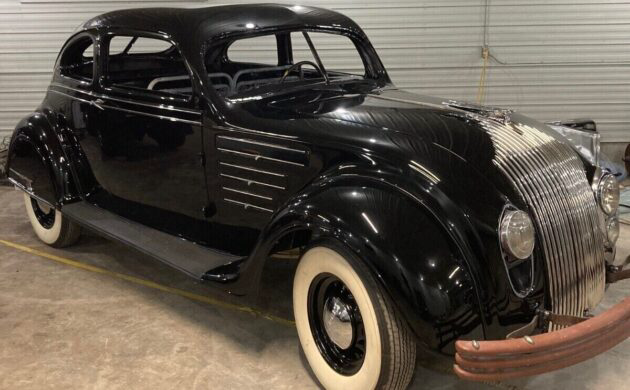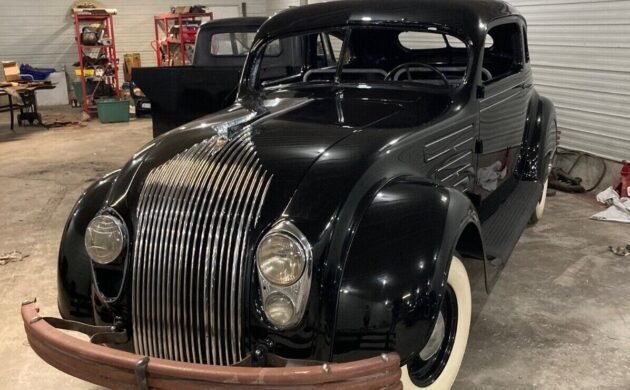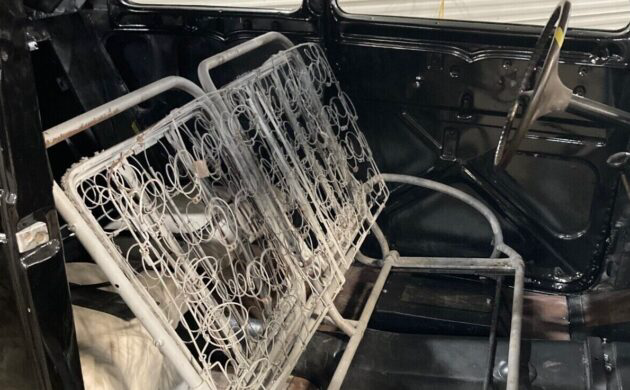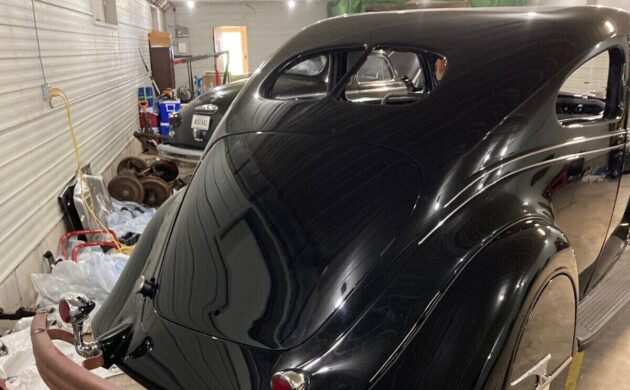Aerodynamic? Yes! Art Deco inspired? Absolutely! Beautiful styling? Ah, well, um, you know, beauty is in the eye of the beholder and that’s how I’d sum up a Chrysler Airflow like this 1934 example. This restored car is a mostly finished project and, it’s a two-door coupe body style – one that I didn’t know existed. Larry D discovered this remarkably designed Airflow here on eBay. It’s located in Mount Brydges, Ontario, Canada and is available for a current bid of $3,528, with the reserve not yet met.
Offered between 1934 and 1937, Chrysler built two and four-door Airflow body styles with a design that primarily emphasized the virtues of streamlining. Chrysler’s corporate cousin, DeSoto, pursued the same path between 1934 and 1936. The total Airflow production reached 26K units over its four-year run but it was ultimately considered a less than successful undertaking. Our subject car is a CU model and is one of only 649 two-door CUs assembled that year. According to the Airflow Club of America, the total Airflow two-door production volume touched just 1,943 copies out of that four-year run of 26K copies – just 7%! Our seller tells us that this car is one of only seven ’34 two-door models still in existence but offers no documentation to attest to that claim. The Airflow Club offers no “currently in existence” estimates.
The seller states that this Chrysler is an “off frame restoration of an excellent bodied, rare, one of approx. (7) seven in existence… Numbers matching car, purchased a few years ago from Chrysler Airflow Club Member“. Looking at the body in its stripped form, it does appear as if the restoration process was very thorough and painstaking. What’s been accomplished looks fantastic, just a bit unfinished and that begs the question, why? The bumpers need to be chromed, the front seat needs to be built, and it looks as if the glass is uninstalled but the heavy lifting has been accomplished. We’re on the ten-yard line, it seems odd that the seller wouldn’t want to cover those last few yards and bring this one home.
The numbers matching engine is a 122 HP, 298 CI in-line, flathead eight-cylinder arrangement. We’re told that it has been rebuilt but there’s no reference to its operating prowess. A three-speed manual transmission was the sole gearbox available.
As referenced earlier, the door panels, upholstery panels, seating innards/upholstery, and maybe the headliner are missing but the dash and instrument panel look complete and clear. The floors show as very sound but there is no underlay/mat/carpeting in place. So OK, maybe we’re on more like the fifteen-yard line but we’re still close to a completely restored automobile.
We’re two days into the bidding and a paltry $3,528 is the best that’s surfaced from the eight bids tendered. There are still eight days to go with the auction but things are looking a little shaky so far. It’s hard to say what the reserve is on this magnificent example of streamlining but I imagine that the current bid is pretty far under what it will take to seal a deal, wouldn’t you agree?








I’m not sure about how they were originally, but (IMO) the bumpers would look better in chrome GLWTA!! :-)
Agreed on the bumpers, the unfinished look was the first thing that grabbed my eye. Even if they weren’t chrome, they need to be chrome, especially since the car has so much already in that waterfall grille. I love the look of the car overall though.
Chrysler was definitely looking ahead with this one. 122 horsepower in 1934 was probably like 400 by today’s standards.
The grill is about 90 years to early. Lexus would be proud
And that grille was one of the things that did in the Airflow. It was too advanced and weird for most Americans, and GM started a character assassination campaign against the car, because GM knew the Airflow was advanced and superior.
Regarding the unfinished items, all sorts of things happen to people. They have health problems, deaths in family. They run out of money. They run out of interest. They have to move. Really, no use speculating.
The result is that this is a very interesting 2-door Airflow model — a style that looks great close up, as I have seen one at Hershey. Everything that needs finishing seems quite in the realm of the possible. For the right price, this would be a great project to complete on a wonderfully engineered car.
Oh!! If only I had the cash and the space for this one! The sedans are cool, but the coupes……..yeah!
The rarest of the rare is the ’34 Imperial CV coupe, with only three known to exist. I believe one of them sold for over $200K at an auction about 5 or 6 years ago.
GM and Ford both engaged in character assassination; the Airflow was one of the first cars built with an all steel body (no wood in the frame) and GM ran ads saying that “Steel was Not Enough!”. GM held onto wood in the frames until 1937, despite the introduction of the Turret Top in 1934.
Chrysler also shot themselves in the foot……trying to get the Airflow to market and work the bugs out of the car at the same time caused them to cut some corners that probably shouldn’t have been cut. Some of the earliest cars had issues with motor mounts and body integrity. That didn’t help with the public’s impression of the cars.
Funny, by the time the Airflow was discontinued in 1937, all cars wore the streamlined look. Chrysler took it on the chin, financially, especially where DeSoto was all Airflow until 1936. Chrysler introduced the Airstream in 1935, which had a more conventional look to it, and the sales of the Airstream bolstered Chrysler sales.
This is a car that, when finished, will turn heads wherever she goes!
Here we go again: in discussing cars of this era, as far as my 80+ year of memories go, a coupe has two doors, 2+2 seating, and a trunk that extends out behind of the body, generally referred to as a 3-box design. In a coupe, the rear seat is usually smaller than the rear seat of a coach. Technically, a coupe has less than 33 cubic feet of rear interior volume.
The other two body styles, either 2 door or 4 door, were commonly known as a coach and a sedan, respectively. Cars today are what the manufacturer call them, but the cars of yesteryear were pretty well defined.
I don’t know if the bumpers were chrome plated; they seemed to look like they were nickel plated.
Is there a thumbs down button? This is no place for pedantics…
The problem with trying to define the use of the word “Coupe” in automotive styling is dependent on such variations as the car’s country of manufacture and how the word is used. The original use was from France, and referred to a “cut down” or altered body line from a 4-door sedan to a 2-door.
The concept of a coupe being a shortened 3-box sedan is one of the accepted uses, but in the case of something like an Airflow or a late 30’s Ford sedan with a fastback body, building those cars as a 2-door [with or without a back seat] could be considered a coupe, especially if it’s on a shortened wheelbase.
In Britain, during the 1950s Rover produced a basic 3-box designed 4-door known as the P-5. But the company also produced what they called the Coupe, as it had a lower [cut-down] roof line, still using a 4-door body. Yes, it’s a 4-door coupe!
For the majority of American car manufacturers up thru the late 1950s, a coupe was defined as a 2-door vehicle without a back seat, usually seating 3 people inside, and with a rumble seat, it could hold up to 6 people, but still be considered a coupe!
In 1951 Packard re-introduced a business coupe, but it was basically a Packard 200 series 2401 2-door sedan without a back seat or rear armrests and fixed rear side windows. Instead there was a partition where the back seat’s upright section would have been. Packard called it a coupe, so ergo, it was a coupe, as it didn’t have a back seat. See photo of the factory brochure, where it’s called a coupe, but it’s the same body as the 2-door sedan.
And of course there are different type of coupes;
3-window, 5 window, business, opera, pickup, roadster, and probably a few more styles I’m forgetting due to old age!
A business coupe usually meant the entire area behind the front seat, all the way back to the bumper, was 1 large cargo area. An opera coupe usually had one or two small folding seats behind the front seat. A coupe pickup had a sliding pickup bed stored inside the large trunk lid, that with the lid open, could be extended about 3 feet rearward over the bumper to provide a 6 foot pickup bed with tailgate. A roadster coupe was a 3 passenger open car without roll-up windows.
So the term “Coupe” is subject to wide differences in use, and it’s designation best left to what the manufacturer chose to call the body it designed and/or manufactured.
I have wanted one of these for a long time.
Wondering if the seller ran out of money during a restoration that he got sucked far farther into than he intended.